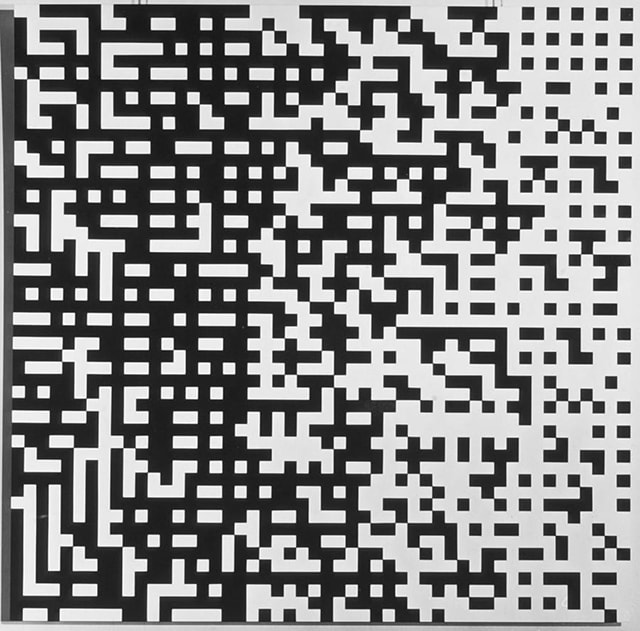title
Computerstructuren
artist
Peter Struycken
intro
Peter Struycken was one of the first artists in the Netherlands that used the computer to create artworks. He has been working with computers since 1968 and is considered a pioneer in Dutch digital (generative) art.
Computerstructuren is his first series of ‘computer paintings’ and consists of eight black and white paintings that were generated by a computer program. Struycken wanted to integrate the element of chance into his work and found that the computer could calculate chance in an unambiguous way. He wanted to show that by using regulated chance a large variety of images can be realised that all meet the same visual characteristics.
For this work, Struycken programmed the computer to randomly divide 16 coloured squares, each time in different proportions, over a grid that was 5 elements wide and 25 elements high. This process resulted in computer generated code that was many meters long. From these lines of code he chose eight fragments to execute as paintings. With these paintings he wanted to point out that by using regulated chance, a variety of images could be realised. As the eight paintings are generated through the same method, they have a similar visual appearance and yet are all different.
biography artist
Peter Struycken (1939, The Hague) is one of the first visual artists in the Netherlands who let the computer play an important role in the creation of his art. From 1957 he studied at the Royal Academy of Art in The Hague and in 1964 he started working as a teacher at ArtEZ in Arnhem, where he founded the department ‘Monumentaal Nieuwe Stijl’, stimulating students to combine art and architecture. In 1984 he was knighted in the Order of Orange-Nassau. His work is mostly abstract and extends from paintings and tapestries to video, costumes, decors, computer programs, and work in public space.
keywords
digital art, generative art, computer art
images
[caption id="attachment_423" align="alignnone" width="640"] © Peter Struycken, Computerstructuur 4A, 1969 c/o Pictoright Amsterdam 2019[/caption]
© Peter Struycken, Computerstructuur 4A, 1969 c/o Pictoright Amsterdam 2019[/caption]
 © Peter Struycken, Computerstructuur 4A, 1969 c/o Pictoright Amsterdam 2019[/caption]
© Peter Struycken, Computerstructuur 4A, 1969 c/o Pictoright Amsterdam 2019[/caption]
year
1969-1972
premiere
The first painting, Computerstructuur 1A, was executed in 1969.
software
Computer program OSTRC, written in Algol 60 by Stan Tempelaars.
functionality
part of collection
Kröller-Müller Museum, Museum Boijmans Van Beuningen, Stedelijk Museum Amsterdam, Museum Voorlinden
production
Struycken’s first computer programs were written in association with Stan Tempelaars and Greta Vermeulen.1 The computer program OSTRC, used for Computerstructuren was written in Algol 60 by Stan Tempelaars while working at the Institute of Sonology in 1969.
hardware
8 abstract paintings, lacquer paint on perspex, 150 x 150 cm
technical specs
The paintings are numbered 1, 1A, 2, 2A, 3, 3A, 4, 4A.
intention artistquote by artist
quote
influence
Struycken’s work can be positioned within the history of avant-garde movements. Chance and rule-based art, which can be seen as a precursor for computer-generated art, has its origins in Dada but was also important in neo-avant-garde movements like Fluxus and conceptual art. In addition, Struycken has a background in concrete art and was surrounded by his peers from experimental art movements like the Zero movement and geometric abstractionists.
Another group experimenting with the computer was Compos 68: a group of three scientists in Utrecht who, in 1968-1969 combined modernist painting with computer programs.2 Other artists that were using the computer for the production of their work during the 60s include Manfred Mohr, Nam June Paik, Vera Molnár, and Frieder Nake. In the Netherlands however, Struycken is considered a pioneer.
Until the 80s, computers could only be found in research institutions and so the first artists to work with the computer were usually scientists and not trained artists. The program for Computerstructuren was developed at the Institute for Sonology in collaboration with physicist Stan Tempelaars and flutist and computer specialist Greta Vermeulen.
Following his first encounter using the computer for Computerstructuren, Struycken pioneered the use of computers in different aspects of visual arts. The computer program used for Computerstructuren, for instance, was reused for an architectural art commission: the sandblasted partition walls on the executive floor of the KLM office in Amsterdam. “Successfully translating data to solid materials, Struycken created fourteen computer-generated permanent public art works until 1980, and many more since.”3
context
LITERATURE
“Peter Struycken.” Peter Struycken, pstruycken.nl.
Blotkamp, Carel, et al. P. Struycken. nai010 Publishers, 2008.
Fritz, Darko. “Mapping the Beginnings of Computer-Generated Art in the Netherlands.” Darko Fritz, 2011, darkofritz.net (pdf).
Videos on the generative work of Peter Struycken: Youtube.com, hollandsemeesters.info.
part of active discussion
scene artists institutes
computer art, generative art, ZERO, Nul, geometric abstraction, Institute of Sonology, University of Utrecht
footnote
1 Carel Blotkamp et al., P. Struycken. (nai010 Publishers, 2008): 108.
2 “Compos 68.” Monoskop, monoskop.org/compos_68.
3 Darko Fritz, “Space of determinism and randomness / Computer-generated art as part and continuation of Concrete art." Mapping the Beginnings of Computer-generated art in the Netherlands, 2011, pp. 19.
Steina »
Annie Abrahams
Livinus van de Bundt & Jeep van de Bundt
Driessens & Verstappen (Erwin Driessens and Maria Verstappen)
Yvonne le Grand
Edward Ihnatowicz
JODI (Joan Heemskerk & Dirk Paesmans)
Bas van Koolwijk
Lancel/Maat (Karen Lancel and Hermen Maat)
Jan Robert Leegte
Peter Luining
Martine Neddam
Marnix de Nijs and Edwin van der Heide
Dick Raaijmakers
Joost Rekveld
Remko Scha
Jeffrey Shaw
Debra Solomon
Steina
Peter Struycken
Michel Waisvisz